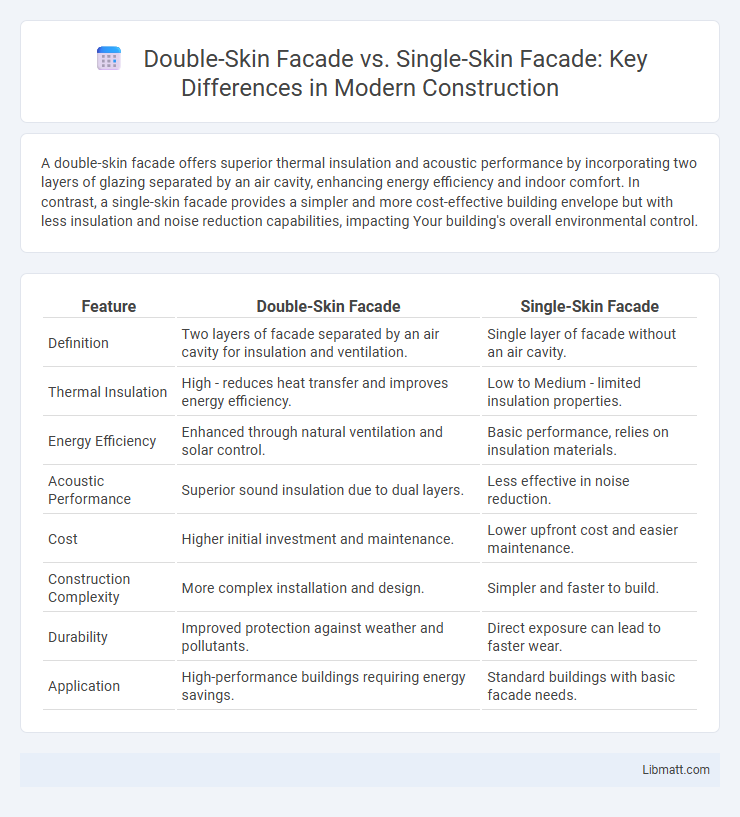A double-skin facade offers superior thermal insulation and acoustic performance by incorporating two layers of glazing separated by an air cavity, enhancing energy efficiency and indoor comfort. In contrast, a single-skin facade provides a simpler and more cost-effective building envelope but with less insulation and noise reduction capabilities, impacting Your building's overall environmental control.
Table of Comparison
| Feature | Double-Skin Facade | Single-Skin Facade |
|---|---|---|
| Definition | Two layers of facade separated by an air cavity for insulation and ventilation. | Single layer of facade without an air cavity. |
| Thermal Insulation | High - reduces heat transfer and improves energy efficiency. | Low to Medium - limited insulation properties. |
| Energy Efficiency | Enhanced through natural ventilation and solar control. | Basic performance, relies on insulation materials. |
| Acoustic Performance | Superior sound insulation due to dual layers. | Less effective in noise reduction. |
| Cost | Higher initial investment and maintenance. | Lower upfront cost and easier maintenance. |
| Construction Complexity | More complex installation and design. | Simpler and faster to build. |
| Durability | Improved protection against weather and pollutants. | Direct exposure can lead to faster wear. |
| Application | High-performance buildings requiring energy savings. | Standard buildings with basic facade needs. |
Introduction to Building Façade Systems
Double-skin facades consist of two layers of glazing separated by an air cavity, enhancing thermal insulation, soundproofing, and energy efficiency compared to single-skin facades with only one layer of glass. This innovative system improves building performance by reducing heat loss in winter and minimizing solar heat gain in summer, contributing to lower HVAC energy consumption. Single-skin facades typically offer limited insulation and rely more on mechanical systems, making double-skin facades a preferred choice for sustainable architecture and climate-responsive designs.
What Is a Single-Skin Façade?
A single-skin facade consists of a single layer of material, typically glass or metal, serving as the primary barrier between the building's interior and exterior environment. This facade type offers straightforward installation and cost efficiency but provides limited thermal insulation and acoustic performance compared to double-skin facades. Single-skin facades rely heavily on supplementary internal climate control systems to maintain occupant comfort and energy efficiency.
Defining Double-Skin Façades
Double-skin facades consist of two layers of exterior walls separated by an air cavity, enhancing thermal insulation and natural ventilation compared to single-skin facades, which have only one layer of material. The air gap in double-skin facades acts as a buffer zone, reducing heat transfer and improving energy efficiency in buildings. This system also provides better acoustic performance and allows for dynamic control of indoor environmental quality.
Key Differences Between Double-Skin and Single-Skin Façades
Double-skin facades consist of two layers of glass separated by an air cavity, enhancing thermal insulation and natural ventilation compared to single-skin facades, which have only one layer of glass. The air cavity in double-skin facades acts as a buffer zone, reducing heat transfer and improving energy efficiency, while single-skin facades typically result in higher heat gain or loss. Maintenance complexity and construction costs are higher for double-skin facades due to their multilayer structure, whereas single-skin facades offer simpler installation and lower upfront expenses.
Energy Efficiency Comparison
Double-skin facades significantly improve energy efficiency by providing enhanced thermal insulation and natural ventilation, reducing heating and cooling demands compared to single-skin facades. The air cavity in double-skin systems acts as a thermal buffer, minimizing heat loss in winter and heat gain in summer, leading to decreased energy consumption. In contrast, single-skin facades often result in higher energy use due to limited insulation and increased reliance on mechanical HVAC systems.
Acoustic Performance Analysis
Double-skin facades significantly improve acoustic performance by providing an additional buffer layer that reduces external noise transmission compared to single-skin facades. The air cavity between the two layers in double-skin systems acts as a sound insulator, mitigating urban noise and enhancing indoor acoustic comfort. Single-skin facades, lacking this intermediate layer, offer limited sound attenuation, making double-skin facades the preferred choice in high-noise environments.
Cost Implications and Investment
Double-skin facades generally involve higher upfront investment due to complex construction, specialized materials, and advanced engineering requirements compared to single-skin facades. Maintenance and operational costs can be lower over time with double-skin systems because of improved energy efficiency and enhanced thermal insulation, potentially leading to significant savings. Your choice between the two should consider long-term cost implications against initial capital expenditure to maximize return on investment.
Installation and Maintenance Considerations
Double-skin facades require more complex installation due to their two-layer structure, involving additional space, materials, and skilled labor compared to single-skin facades that are simpler and quicker to install. Maintenance for double-skin systems involves regular inspection of both layers, ensuring the cavity remains clean and free of debris, while single-skin facades typically require less frequent upkeep. Your choice between the two should consider long-term maintenance costs and the capability for access during repairs or cleaning.
Design Flexibility and Aesthetic Potential
Double-skin facades offer superior design flexibility by allowing dynamic ventilation control and accommodating integrated shading systems, enhancing energy efficiency and occupant comfort. Their multi-layered structure provides architects with diverse aesthetic options, such as varied textures and depth effects, which a single-skin facade typically cannot achieve. Your building's visual appeal and environmental responsiveness can be significantly elevated through the innovative possibilities presented by double-skin facades.
Choosing the Right Façade for Your Project
Selecting the right facade involves understanding the energy performance and cost implications of double-skin versus single-skin facades. Double-skin facades provide superior thermal insulation and natural ventilation, reducing HVAC energy consumption in commercial buildings. Single-skin facades offer cost-effective installation and simpler maintenance, making them ideal for projects with budget constraints or less stringent energy efficiency requirements.
Double-skin façade vs single-skin façade Infographic

 libmatt.com
libmatt.com